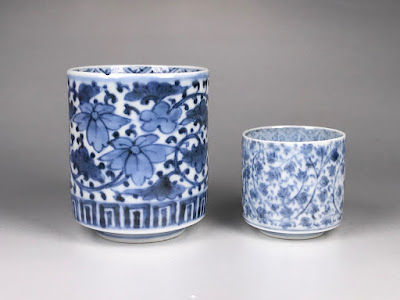染付 唐草文 二種 Arabesque Pattern
左 Left: 口径 width 54 mm / 高さ height 65 mm / 江戸中期 Mid Edo
右 Right: 口径 width 40 mm / 高さ height 40 mm / 江戸中期 Mid Edo
この手の筒形の器を「のぞき猪口」とか「酢猪口」などと呼ぶ。上からのぞかないと、中に何が入ってるかわからないから、また酢などの調味料を入れてお膳に添えたから、と言われる。日常の器というよりも、正月とか冠婚葬祭などのあらたまった会食でつかわれたものであろう。
標準的なのぞきは、横幅が 4.5 〜 5 cm、高さが 5 〜 5.5 cm 程度だが、上の写真は、そのうちでも最大級と最小級のものである。ともに唐草文様が染付で描かれる。小さい方は実用というよりも雛道具のようなものかもしれない。
のぞき猪口にはいろいろと「お約束」がある。まず口縁の内側には四方襷文様が帯状に描かれることが多い。江戸後期になると、これが省略され、二重線とかもうちょっと簡略化された文様など、バリエーションが出てくる。それからそば猪口のようなベタ底でなく、お茶碗のようにかならず出っぱった高台がついている。これはお膳の上にのる、という格の高さを示していると思われる。高台の側面には染付で一重または二重の線が引かれる。
こういう小さい脇役の器にも、きめ細かい文様や細工をほどこすというところに、日本人の日本人たるゆえんが見える気がする。
This kind of cylindrical Imari cup is called nozoki (to look down) or su-choko (vinegar pot), because it is hard to see what is contained unless one looks down from above and the cup was used as a container of vinegar at a formal banquet in Edo period. A regular size varies from 4.5 to 5 cm in width and from 5 to 5.5 cm in height. The above are the biggest and smallest examples, both of which are decorated with arabesque patterns.
There are some "rules" in nozoki cups. A pattern of successive squares is often drawn inside of the cup near the top. In the 19th century, it is simplified as double lines. Nozoki has a circular projection at the bottom, which is contrary to soba-choko and probably shows a higher status in tablewares.


